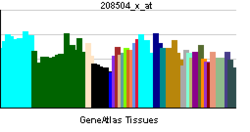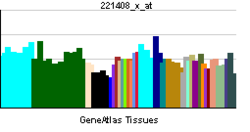- PCDHB15
-
Protocadherin beta 15 Identifiers Symbols PCDHB15; PCDH-BETA15 External IDs OMIM: 606341 MGI: 2136760 HomoloGene: 113752 GeneCards: PCDHB15 Gene Gene Ontology Molecular function • calcium ion binding Cellular component • plasma membrane
• integral to plasma membraneBiological process • cell adhesion
• homophilic cell adhesion
• nervous system developmentSources: Amigo / QuickGO RNA expression pattern 

More reference expression data Orthologs Species Human Mouse Entrez 56121 93893 Ensembl ENSG00000113248 ENSMUSG00000073591 UniProt Q9Y5E8 n/a RefSeq (mRNA) NM_018935 NM_053147.3 RefSeq (protein) NP_061758 NP_444377.3 Location (UCSC) Chr 5:
140.63 – 140.63 MbChr 18:
37.68 – 37.68 MbPubMed search [1] [2] Protocadherin beta-15 is a protein that in humans is encoded by the PCDHB15 gene.[1][2]
This gene is a member of the protocadherin beta gene cluster, one of three related gene clusters tandemly linked on chromosome five. The gene clusters demonstrate an unusual genomic organization similar to that of B-cell and T-cell receptor gene clusters. The beta cluster contains 16 genes and 3 pseudogenes, each encoding 6 extracellular cadherin domains and a cytoplasmic tail that deviates from others in the cadherin superfamily. The extracellular domains interact in a homophilic manner to specify differential cell-cell connections. Unlike the alpha and gamma clusters, the transcripts from these genes are made up of only one large exon, not sharing common 3' exons as expected. These neural cadherin-like cell adhesion proteins are integral plasma membrane proteins. Their specific functions are unknown but they most likely play a critical role in the establishment and function of specific cell-cell neural connections.[2]
References
- ^ Wu Q, Maniatis T (Jul 1999). "A striking organization of a large family of human neural cadherin-like cell adhesion genes". Cell 97 (6): 779–90. doi:10.1016/S0092-8674(00)80789-8. PMID 10380929.
- ^ a b "Entrez Gene: PCDHB15 protocadherin beta 15". http://www.ncbi.nlm.nih.gov/sites/entrez?Db=gene&Cmd=ShowDetailView&TermToSearch=56121.
Further reading
- Nollet F, Kools P, van Roy F (2000). "Phylogenetic analysis of the cadherin superfamily allows identification of six major subfamilies besides several solitary members.". J. Mol. Biol. 299 (3): 551–72. doi:10.1006/jmbi.2000.3777. PMID 10835267.
- Yagi T, Takeichi M (2000). "Cadherin superfamily genes: functions, genomic organization, and neurologic diversity.". Genes Dev. 14 (10): 1169–80. PMID 10817752.
- Gerhard DS, Wagner L, Feingold EA, et al. (2004). "The status, quality, and expansion of the NIH full-length cDNA project: the Mammalian Gene Collection (MGC).". Genome Res. 14 (10B): 2121–7. doi:10.1101/gr.2596504. PMC 528928. PMID 15489334. http://www.pubmedcentral.nih.gov/articlerender.fcgi?tool=pmcentrez&artid=528928.
- Strausberg RL, Feingold EA, Grouse LH, et al. (2003). "Generation and initial analysis of more than 15,000 full-length human and mouse cDNA sequences.". Proc. Natl. Acad. Sci. U.S.A. 99 (26): 16899–903. doi:10.1073/pnas.242603899. PMC 139241. PMID 12477932. http://www.pubmedcentral.nih.gov/articlerender.fcgi?tool=pmcentrez&artid=139241.
- Vanhalst K, Kools P, Vanden Eynde E, van Roy F (2001). "The human and murine protocadherin-beta one-exon gene families show high evolutionary conservation, despite the difference in gene number.". FEBS Lett. 495 (1-2): 120–5. doi:10.1016/S0014-5793(01)02372-9. PMID 11322959.
- Wu Q, Zhang T, Cheng JF, et al. (2001). "Comparative DNA sequence analysis of mouse and human protocadherin gene clusters.". Genome Res. 11 (3): 389–404. doi:10.1101/gr.167301. PMC 311048. PMID 11230163. http://www.pubmedcentral.nih.gov/articlerender.fcgi?tool=pmcentrez&artid=311048.
- Wu Q, Maniatis T (2000). "Large exons encoding multiple ectodomains are a characteristic feature of protocadherin genes.". Proc. Natl. Acad. Sci. U.S.A. 97 (7): 3124–9. doi:10.1073/pnas.060027397. PMC 16203. PMID 10716726. http://www.pubmedcentral.nih.gov/articlerender.fcgi?tool=pmcentrez&artid=16203.
Categories:- Human proteins
- Chromosome 5 gene stubs
Wikimedia Foundation. 2010.
